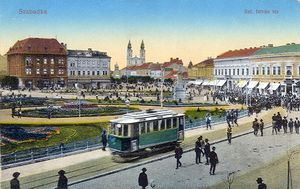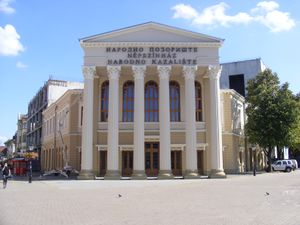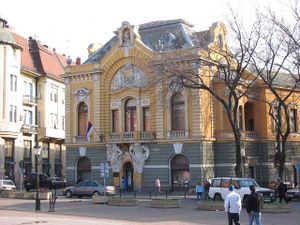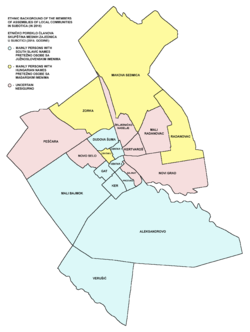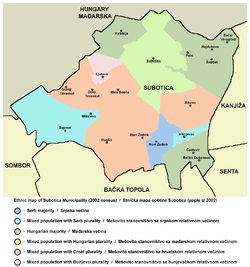سوبوتيتسا
Subotica
Суботица Szabadka | |
|---|---|
| City of Subotica | |
|
From top: Panorama of Subotica, City center, City hall, Subotica Synagogue, Reichel Palace, St. Theresa of Avila Cathedral, Monument to the Victims of Fascism | |
Location of the city of Subotica in Serbia | |
| الإحداثيات: 46°06′01″N 19°39′56″E / 46.10028°N 19.66556°E | |
| Country | Serbia |
| Province | Vojvodina |
| District | North Bačka |
| Settlements | 19 |
| الحكومة | |
| • Mayor | Bogdan Laban (SNS) |
| المساحة | |
| ترتيب المساحة | 13th in Serbia |
| • Urban | 164٫33 كم² (63٫45 ميل²) |
| • Administrative | 1٬007٫47 كم² (388٫99 ميل²) |
| المنسوب | 109 m (358 ft) |
| التعداد (2011 census)[1] | |
| • City | 97٬910 |
| • الترتيب | 6th in Serbia |
| • Urban | 105٬681 |
| • كثافة Urban | 640/km2 (1٬700/sq mi) |
| • Administrative | 141٬554 |
| • كثافة Administrative | 140/km2 (360/sq mi) |
| منطقة التوقيت | UTC+1 (CET) |
| • الصيف (التوقيت الصيفي) | UTC+2 (CEST) |
| Postal code | 24000 |
| مفتاح الهاتف | (+381) 24 |
| لوحة السيارة | SU |
| الموقع الإلكتروني | Official website |
Subotica (سيريلية صربية: Суботица [sǔbotitsa] (![]() استمع), مجرية: Szabadka) is a city and the administrative center of the North Bačka District in the autonomous province of Vojvodina, Serbia. Formerly the largest city of Vojvodina region, contemporary Subotica is now the second largest city in the province, following the city of Novi Sad. According to the 2011 census, the city itself has a population of 97,910, while the urban area of Subotica (with adjacent urban settlement of Palić included) has 105,681 inhabitants, and the population of metro area (the administrative area of the city) stands at 141,554 people.[1]
استمع), مجرية: Szabadka) is a city and the administrative center of the North Bačka District in the autonomous province of Vojvodina, Serbia. Formerly the largest city of Vojvodina region, contemporary Subotica is now the second largest city in the province, following the city of Novi Sad. According to the 2011 census, the city itself has a population of 97,910, while the urban area of Subotica (with adjacent urban settlement of Palić included) has 105,681 inhabitants, and the population of metro area (the administrative area of the city) stands at 141,554 people.[1]
Geography
It is located in the Pannonian Basin at 46.07° North, 19.68° East, about 10 kilometres (6 miles) from the border with Hungary, and is the northernmost city in Serbia. It is located in the vicinity of lake Palić.[بحاجة لمصدر]
التاريخ
قبل التاريخ والقِدم
In Neolithic and Eneolithic period, several important archaeological cultures flourished in this area, including the Starčevo culture,[2] the Vinča culture,[3] and the Tiszapolgár culture.[4] First Indo-European[بحاجة لمصدر] peoples settled in the territory of present-day Subotica in 4200 BC. During the Eneolithic period, the Bronze Age and the Iron Age, several Indo-European archaeological cultures included areas around Subotica - the Baden culture, the Vučedol culture,[5] the Urnfield culture[6] and some other. Before the Iazyge conquest in the 1st century, Indo-European peoples of Illyrian, Celtic and Dacian descend inhabited this area. In the 3rd century BC, this area was controlled by Celtic Boii and Eravisci, while in the 1st century BC, it became part of the Dacian kingdom. Since the 1st century, the area came under control of the Sarmatian Iazyges (which possibly included Serboi[بحاجة لمصدر] tribe), who occasionally were allies and occasionally enemies of the Romans. Iazyge rule lasted until the 4th century, after which the region came into the possession of various other peoples and states.
مطلع العصور الوسطى والاستيطان السلاڤي
In the Early Middle Ages various Indo-European and Turkic peoples and states ruled in the area of Subotica. These peoples included Huns, Gepids, Avars, Slavs and Bulgarians. Slavs settled today's Subotica in the 6th and 7th centuries, before some of them crossed the rivers Sava and Danube and settled in the Balkans.
The Slavic tribe living in the territory of present-day Subotica were the Obotrites, a subgroup of the Serbs. In the 9th century, after the fall of the Avar state, the first forms of Slavic statehood emerged in this area. The first Slavic states that ruled over this region included the Principality of Lower Pannonia, Great Moravia and the Bulgarian Empire.
أواخر العصور الوسطى

Subotica probably first became a settlement of note when people poured into it from nearby villages destroyed during the Tatar invasions of 1241–42. However the settlement has surely been older. It has been established that people inhabited these territories even 3000 years ago.[بحاجة لمصدر] When Zabadka/Zabatka was first recorded in 1391, it was a tiny town in the medieval Kingdom of Hungary. Later, the city belonged to the Hunyadis, one of the most influential aristocratic families in the whole of Central Europe.
King Matthias Corvinus of Hungary gave the town to one of his relatives, János Pongrác Dengelegi, who, fearing an invasion by the Ottoman Empire, fortified the castle of Subotica, erecting a fortress in 1470. Some decades later, after the Battle of Mohács in 1526, the Subotica became part of the Ottoman Empire. The majority of the Hungarian population fled northward to Royal Hungary.[بحاجة لمصدر] Bálint Török, a local noble who had ruled over Subotica, also escaped from the city. During the military and political havoc following the defeat at Mohács, Subotica came under the control of Serbian mercenaries recruited in Banat. These soldiers were in the service of the Transylvanian general John I Zápolya, a later Hungarian king.[بحاجة لمصدر]
The leader of these mercenaries, Jovan Nenad, established in 1526–27 his rule in Bačka, northern Banat and a small part of Syrmia and created an independent entity, with Subotica as its administrative centre. At the peak of his power, Jovan Nenad proclaimed himself as Serbian tsar in Subotica. He named Radoslav Čelnik as the general commander of his army, while his treasurer and palatine was Subota Vrlić, a Serbian noble from Jagodina. When Bálint Török returned and recaptured Subotica from the Serbs, Jovan Nenad moved the administrative centre to Szeged.[7]
Some months later, in the summer of 1527, Jovan Nenad was assassinated and his entity collapsed. However, after Jovan Nenad's death, Radoslav Čelnik led the remains of the army to Ottoman Syrmia, where he briefly ruled as Ottoman vassal.[بحاجة لمصدر]
الادارة العثمانية
![]() الدولة العثمانية 1542–1686
الدولة العثمانية 1542–1686
![]() ملكية هابسبورگ 1686–1804
ملكية هابسبورگ 1686–1804
![]() الإمبراطورية النمساوية 1804–1867
الإمبراطورية النمساوية 1804–1867
![]() امبراطورية النمسا-المجر 1867–1918
امبراطورية النمسا-المجر 1867–1918
![]() مملكة صربيا 1918
مملكة صربيا 1918
![]() مملكة يوغسلاڤيا[8] 1918–1941
مملكة يوغسلاڤيا[8] 1918–1941
![]() مملكة المجر 1941–1944
مملكة المجر 1941–1944
![]() يوغوسلاڤيا[9] 1944–1992
يوغوسلاڤيا[9] 1944–1992
![]() جمهورية يوغسلاڤيا الاتحادية 1992−2003
جمهورية يوغسلاڤيا الاتحادية 1992−2003
![]() صربيا والجبل الأسود 2003–2006
صربيا والجبل الأسود 2003–2006
The Ottoman Empire ruled the city from 1542 to 1686. At the end of this almost 150-year-long period, not much remained of the old town of Zabadka/Zabatka. As much of the population had fled, the Ottomans encouraged the settlement of the area by different colonists from the Balkans. The settlers were mostly Orthodox Serbs. They cultivated the extremely fertile land around Subotica. In 1570, the population of Subotica numbered 49 houses, and in 1590, 63 houses. In 1687, the region was settled by Catholic Dalmatas (called Bunjevci today). It was called Sobotka under Ottoman rule and was a kaza centre in Segedin sanjak at first in Budin Eyaleti until 1596, and after that in Eğri Eyaleti between 1596–1686.[10]
ادارة هابسبورگ
In 1687, about 5,000 Bunjevci, led by Dujo Marković and Đuro Vidaković settled in Bačka (including Subotica). After the decisive battle against the Ottomans at Senta led by Prince Eugene of Savoy on 11 September 1697, Subotica became part of the military border zone Theiss-Mieresch established by the ملكية هابسبورگ. In the meantime the uprising of Francis II Rákóczi broke out, which is also known as the Kuruc War.
In the region of Subotica, Rákóczi joined battle against the Rac National Militia. Rác was a designation for the South Slavic people (mostly Serbs and Bunjevci) and they often were referred to as rácok في مملكة المجر. In a later period rácok came to mean, above all, Serbs of Orthodox religion.[بحاجة لمصدر] The Serbian military families enjoyed several privileges thanks to their service لملكية هابسبورگ. Subotica gradually, however, developed from being a mere garrison town to becoming a market town with its own civil charter in 1743. When this happened, many Serbs complained about the loss of their privileges. The majority left the town in protest and some of them founded a new settlement just outside 18th century Subotica in Aleksandrovo, while others emigrated to Russia. In New Serbia, a new Russian province established for them, those Serbs founded a new settlement and also named it Subotica. In 1775, a Jewish community in Subotica was established.
It was perhaps to emphasise the new civic serenity of Subotica that the pious name Saint Mary came to be used for it at this time. Some decades later, in 1779, Empress Maria Theresa of Austria advanced the town's status further by proclaiming it a Free Royal Town. The enthusiastic inhabitants of the city renamed Subotica once more as Maria-Theresiopolis.
This Free Royal Town status gave a great impetus to the development of the city. During the 19th century its population doubled twice, attracting many people from all over the ملكية هابسبورگ. This led eventually to a considerable demographic change. In the first half of the 19th century, the Bunjevci had still been in the majority, but there was an increasing number of Hungarians and Jews settling in Subotica. This process was not stopped even by the outbreak of the الثورات في ملكية هابسبورگ (1848-49).
ثورات 1848/1849
During the 1848-49 revolution, the proclaimed borders of autonomous Serbian Vojvodina included Subotica, but Serb troops could not establish control in the region. On 5 March 1849, at the locality named Kaponja (between Tavankut and Bajmok), there was a battle between Serb and Hungarian army, which was won by the Hungarians.
The first newspaper in the town was also published during the 1848/49 revolution—it was called Honunk állapota ("State of Our Homeland") and was published in Hungarian by Károly Bitterman's local printing company. Unlike most Serbs and Croats who confronted with Hungarians, part of the local Bunjevci people supported Hungarian revolution.
In 1849, after the Hungarian revolution of 1848 was defeated by the Russian and Habsburg armies, the town was separated from the Kingdom of Hungary together with most of the Bačka region, and became part of a separate Habsburg province, called Voivodeship of Serbia and Banat of Temeschwar. The administrative center of this new province was Timişoara. The province existed until 1860. During the existence of the voivodeship, in 1853, Subotica acquired its impressive theatre.
الادارة المجرية
After the establishment of the Dual-Monarchy in 1867, there followed what is often called the "golden age" of city development of Subotica. Many schools were opened after 1867 and in 1869 the railway connected the city to the world. In 1896 an electrical power plant was built, further enhancing the development of the city and the whole region. Subotica now adorned itself with its remarkable Central European, fin de siècle architecture. In 1902 a Jewish synagogue was built in the Art Nouveau style.
Between 1849 and 1860 it was part of the Voivodeship of Serbia and Banat of Temeschwar.[11]
يوغسلاڤيا وصربيا
Subotica was part of Austria-Hungary until the aftermath of World War I in 1918, when the city became part of the Kingdom of Serbs, Croats and Slovenes. In changed economic and political circumstances, Subotica was now a border-town in Yugoslavia and did not, for a time, experience again the dynamic prosperity it enjoyed in the years preceding World War I. However, at that time, Subotica was the third largest city in Yugoslavia by population, following Belgrade and Zagreb.
In 1941, Yugoslavia was invaded and partitioned by the Axis Powers, and its northern parts, including Subotica, were annexed by Hungary (This partition of Yugoslavia was not recognized by the international community and city was, from the legal point of view, still part of Yugoslavia, whose only legal representative was Yugoslav government in exile). Hungarian troops entered Subotica on 11 April 1941.
As the majority of people living in the city were ethnic Hungarians and the city had been part of Hungary for over 600 years, Hungary felt it had to protect its people now living outside of its borders. During World War II the city lost approximately 7,000 of its citizens, mostly Serbs, Hungarians and Jews. Before the war about 6,000 Jews lived in Subotica; many of these were deported from the city during the Holocaust, mostly to Auschwitz.
In April 1944 a ghetto was set up. Also, many communists were put to death during Axis rule. In 1944, the Axis forces left city, and Subotica became part of the new Yugoslavia. During the 1944–45 period about 8,000 citizens (mainly Hungarian) were killed by Partisans re-taking the city as retribution for supporting Axis Hungary.[12][13]
في فترة ما بعد الحرب، تعصرنت سوبتيتسا تدريجياً. أثناء الحروب اليوغسلاڤية والكوسوڤارية في ع1990، a considerable number of Serb refugees came to the city from كرواتيا والبوسنة والهرسك وكوسوڤو, while many ethnic Hungarians and Croats, as well as some local Serbs, left the region due to economical stagnation and fear of racism.[بحاجة لمصدر]
منظر المدينة
Unique in Serbia, Subotica has the most buildings built in the art nouveau style. The City Hall (built in 1908-1910) and the Synagogue (1902) are of especially outstanding beauty. These were built by the same architects, Marcell Komor and Dezső Jakab, from Budapest, Hungary. Another exceptional example of art nouveau architecture is the actual Artistic Encounter building, which was built in 1904 by Ferenc J. Raichle.
Demographics
| Year | Pop. | ±% p.a. |
|---|---|---|
| 1948 | 123٬668 | — |
| 1953 | 126٬559 | +0.46% |
| 1961 | 136٬782 | +0.98% |
| 1971 | 146٬770 | +0.71% |
| 1981 | 154٬611 | +0.52% |
| 1991 | 150٬534 | −0.27% |
| 2002 | 148٬401 | −0.13% |
| 2011 | 141٬554 | −0.52% |
| Source: [14] | ||
According to the 2011 census results, the city administrative area of Subotica had 141,554 inhabitants.
Ethnic composition
Places with either an absolute or relative Hungarian ethnic majority are: Subotica (Hungarian: Szabadka), Palić (Hungarian: Palicsfürdő), Hajdukovo (Hungarian: Hajdújárás), Bački Vinogradi (Hungarian: Bácsszőlős), Šupljak (Hungarian: Alsóludas), Čantavir (Hungarian: Csantavér), Bačko Dušanovo (Hungarian: Zentaörs), and Kelebija (Hungarian: Alsókelebia). Places with an absolute or relative Serb ethnic majority are: Bajmok, Višnjevac, Novi Žednik, and Mišićevo. Places with a relative ethnic majority Croat are: Mala Bosna, Đurđin, Donji Tavankut, Gornji Tavankut, Bikovo, Stari Žednik. Ljutovo has a relative Bunjevac ethnic majority.
The ethnic composition of the municipality:[15]
| Ethnic group | Population |
|---|---|
| Hungarians | 50,469 |
| Serbs | 38,254 |
| Croats | 14,151 |
| Bunjevci | 13,553 |
| Yugoslavs | 3,202 |
| Roma | 2,959 |
| Montenegrins | 1,349 |
| Macedonians | 482 |
| Albanians | 383 |
| Muslims | 334 |
| Germans | 260 |
| Bosniaks | 216 |
| Rusyns | 172 |
| Slovenians | 169 |
| Slovaks | 158 |
| Gorani | 151 |
| Others | 15,292 |
| Total | 141,554 |
Languages
Languages spoken in Subotica administrative area:[16]
- Serbian = 63,412 (44.80%)
- Hungarian = 50,621 (35.76%)
- Bunjevac = 6,313 (4.46%)
- Croatian = 5,758 (4.07%)
- Others
Serbian is the most employed language in daily life, but Hungarian is also used by almost one third of the population in their daily conversations. Both languages are also widely employed in commercial and official signage [17]
Religion
Religion in Subotica administrative area as of the 2011 census:[16]
- Roman Catholic = 81,532 (57.60%)
- Orthodox = 39,333 (27.79%)
- Muslim = 2,756 (1.95%)
- Protestant = 2,372 (1.68%)
- Judaism = 89 (0.001%)
Subotica is the centre of the Roman Catholic diocese of the Bačka region. The Subotica area has the highest concentration of Catholics in Serbia. 57% of the city's population are Catholics. There are eight Catholic parish churches, a Franciscan spiritual centre (the city has communities of both Franciscan friars and Franciscan nuns), a female Dominican community, and two congregations of Augustinian religious sisters. The diocese of Subotica has the only Catholic secondary school in Serbia (Paulinum).[بحاجة لمصدر]
علاقات التعاون الدولي
- سوبتيتسا هي مدينة رائدة في مجلس أوروپا وبرنامج المدن متعددة الثقافات التابع للاتحاد الأوروپي.[18]
البلدات التوأم - المدن الشقيقة
Subotica is twinned with the following cities:
|
المدن الشريكة
Subotica is a partner city with the following:
|
|
See also
- List of mayors of Subotica
- Municipalities of Serbia
- List of cities in Serbia
- List of cities, towns and villages in Vojvodina
- North Bačka District
References
- ^ أ ب قالب:Serbian census 2011
- ^ http://freepages.genealogy.rootsweb.ancestry.com/~hjohnson/New%20Index/Family%20Groups/Group%20Leaders%20Pages/Pin%20Oak%20Reports/inthebeginningupdated2009_files/image010.jpg[dead link]
- ^ "Map". catyline.com.
- ^ "[Projekat Rastko] Nikola Tasic: Eneolitske kulture centralnog i zapadnog Balkana". www.rastko.rs.
- ^ "Archived copy". Archived from the original on 2011-07-14. Retrieved 2011-02-12.
{{cite web}}: Unknown parameter|deadurl=ignored (|url-status=suggested) (help)CS1 maint: archived copy as title (link), - ^ eliznik. "South East Europe history - 1,800 BC map". www.eliznik.org.uk. Archived from the original on 2013-03-25. Retrieved 2013-01-14.
{{cite web}}: Unknown parameter|dead-url=ignored (|url-status=suggested) (help) - ^ Borovszky Samu: Magyarország vármegyéi és városai, Bács-Bodrog vármegye I-II. kötet, Apolló Irodalmi és Nyomdai Részvénytársaság, 1909.
- ^ عُرفت رسمياً بإسم مملكة الصرب والكروات والسلوڤين حتى 1929
- ^ عُرفت بإسم يوغسلاڤيا الاتحادية الديمقراطية حتى 1945
- ^ Sanjak of Segedin
- ^ "Subotica | Hrvatska enciklopedija". www.enciklopedija.hr. Retrieved 2019-05-04.
- ^ Mészáros Sándor: Holttá nyilvánítva - Délvidéki magyar fátum 1944–45, I-II, Hatodik Síp Alapítvány, Budapest 1995.
- ^ Cseres Tibor: Vérbosszú Bácskában, Magvető kiadó, Budapest 1991.
- ^ "2011 Census of Population, Households and Dwellings in the Republic of Serbia" (PDF). stat.gov.rs. Statistical Office of the Republic of Serbia. Retrieved 19 March 2017.
- ^ "Попис становништва, домаћинстава и станова 2011. у Републици Србији" (PDF). stat.gov.rs. Republički zavod za statistiku. Retrieved 10 April 2019.
- ^ أ ب "Archived copy" (PDF). Archived from the original (PDF) on 15 July 2014. Retrieved 17 December 2016.
{{cite web}}: Unknown parameter|deadurl=ignored (|url-status=suggested) (help)CS1 maint: archived copy as title (link) - ^ "The Use of Hungarian and Serbian in the City of Szabadka/Subotica: An Empirical Study". Retrieved 8 September 2017.
- ^ "Intercultural Cities - Home". Intercultural cities programme.
Sources
- Recent (2002) statistical information comes from the Serbian statistical office.
- Ethnic statistics: "КОНАЧНИ РЕЗУЛТАТИ ПОПИСА 2002" (PDF). Archived from the original (PDF) on 2009-02-25.
{{cite web}}: Unknown parameter|deadurl=ignored (|url-status=suggested) (help) (477 KB), САОПШTЕЊЕ СН31, брoј 295 • год. LII, 24.12.2002, YU ISSN 0353-9555. Accessed 17 January 2006. On page 6–7, Становништво према националној или етничкој припадности по попису 2002. Statistics can be found on the lines for "Суботица" (Subotica). - Language and religion statistics: Popis stanovništva, domaćinstava i stanova u 2002, ISBN 86-84433-02-5. Accessed 17 January 2006. On page 11–12: СТАНОВНИШТВО ПРЕМА ВЕРОИСПОВЕСТИ, СТАНОВНИШТВО ПРЕМА МАТЕРЊЕМ ЈЕЗИКУ. Statistics can be found on the lines for "Суботица" (Subotica).
- Ferdinand, S. and F. Komlosi. 2017. The Use of Hungarian and Serbian in the City of Szabadka/Subotica: An Empirical Study, Hungarian Cultural Studies, Volume 10. Accessed 08 September 2017.
- Ethnic statistics: "КОНАЧНИ РЕЗУЛТАТИ ПОПИСА 2002" (PDF). Archived from the original (PDF) on 2009-02-25.
External links
- Pages using gadget WikiMiniAtlas
- Articles with dead external links from November 2017
- CS1 errors: unsupported parameter
- Short description is different from Wikidata
- Coordinates on Wikidata
- Articles containing صربية-language text
- Articles containing مجرية-language text
- Pages using Lang-xx templates
- Articles with unsourced statements from March 2016
- Articles with unsourced statements from September 2013
- Articles with unsourced statements from January 2013
- مقالات ذات عبارات بحاجة لمصادر
- Articles with hatnote templates targeting a nonexistent page
- Articles with unsourced statements from February 2016
- Pages with empty portal template
- عواصم تاريخية صربية
- Subotica
- Places in Bačka
- Populated places in Vojvodina
- Municipalities and cities of Vojvodina
- North Bačka District
- Former capitals of Serbia










